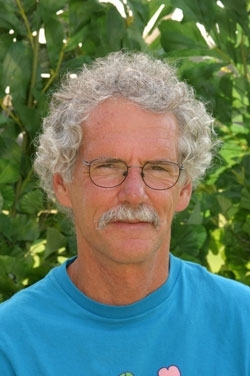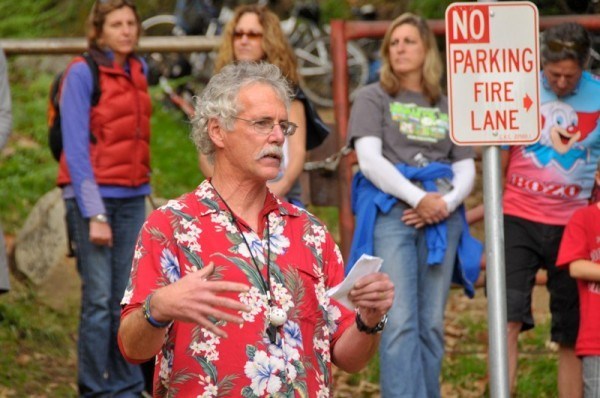 |
| John Seigel Boettner ( (photo courtesy of Santa Barbara Middle School)) |
John Seigel Boettner is one of those teachers we all wish we'd had in middle school. Whether working in his Santa Barbara Middle School classroom, where his motto, "Carpe Diem," hangs distinctly above the door, or leading a bike expedition in some remote part of the world, he teaches, by example, that learning and life are great adventures.
Seigel Boettner, or John S.B. to his students, didn't set out to become a teacher. He graduated in the early 1970s as a student of architecture from the University of Southern California. Then, one day, when he was working as a substitute teacher, he realized the course of his life was about to change.
"I was just working as a substitute teacher to put gas in my car," he said. " But, when I walked onto the playground, I fell in love with the kids."
Seigel Boettner brings his classroom out into the world and the world into his classroom using the mediums of bicycles and film. Growing up in Santa Barbara, John was always an avid cyclist.He and his wife Lynn Seigel-Boettner, a kindergarten teacher, even brought their sons Jacob and Isaac home from the hospital on a trailer towed behind his bike.
"The first time, my mother in law wanted to kill me," said Seigel Boettner. "The second time, she told everyone in the lobby."
A cross-country bicycle trip with 5 12 and 12-year-olds provided the inspiration for, "Hey Mom, Can I Ride My Bike Across America?: Five Kids Meet Their Country." The book, by Seigel Boettner, chronicles the group's perseverance through snowstorms, intense heat and even a tornado.
In 2008, he took a group of middle school students on a bike ride through the Republic of Rwanda, in central eastern Africa. There, they met children and adults whose families were torn apart by civil war and genocide that claimed more than half a million lives and whose stories will stay with the students forever.
The most important part of the journey is, "bringing it back, examining the things that make a community," said Seigel Boettner. "The biggest effect is down the road a couple of years."
Today, Seigel Boettner shares his love of biking with his students through twice-yearly, multi-day bike excursions sanctioned by SBMS. The parents and teachers get a glimpse into the adventure through a 20-minute video diary of the journey, which is screened at SBMS's year's-end culmination. This choice of medium is represents another of Seigel Boettner's teaching tools and passions, the powerful vehicle of film.
"I'm not beholden pen and ink or stone tablet or the human voice. It's the story that's immortal," he said. "Visual media can captivate most kids in my audience. It's an orchestration of the arts. There's color, there's literature, there's music. That's so effective, when those things come together."
Seigel Boettner said he was awed by the power of film after watching the documentary Seven Up, which followed the lives of 14 British children for 49 years, screening a new episode every seven years.
"I had the kids watch that series, and do the same things with themselves," said Seigel Boettner. "I had them make a conclusion at 35 and 42. That was very powerful and I've learned that using film and then tying it into someone's personal life space made a big difference."
He points out that the global implications of using film as a teaching tool are huge. "Most humans see and hear. Not all humans read," he said. "If you set a book in the road, no matter how good it may be, not everyone has the tools to use it but if you show a movie in the middle of the desert, people will come. It's the biggest multi-sensory thing that we have and now that the projection of it is pretty simple, people will come."
Seigel Boettner teaches his students to respect the medium as well as its capacity to manipulate thought and emotion. He also uses film as a catalyst for human interaction and invites parents to a monthly film screening and discussion.
"I want kids to be able to watch a film in a safe environment and to talk about it," he said. "Something might happen at the dinner table or on the way to soccer practice that might spark a discussion. Some of the things may be so powerful that you can't help but talk about it."
 |
| John Seigel Boettner (Lori Rafferty) |
Years ago, when the Santa Barbara International Film Festival was coming to town, Seigel Boettner wanted to give his students a chance to talk to some of Hollywood's top movie makers. "
I considered the films that came to town and the filmmakers that came to town and the role of film in the present and in the future," he said. "I felt it was a unique opportunity."
The students applied for press credentials and Seigel Boettner taught them the skills of interviewing. However, he wasn't interested in discovering the stars' styles of dress or learning about their latest relationship. He wanted to know what they were doing as human beings.
John SB instructed his eager young reporters to do their research and to find something in that research that resonated with them. "Hopefully, if it's a good interview, you won't have a chance to get to the second question on your list because you will start talking," he said.
Next, the students had to formulate a question for the celebrities but Seigel Boettner set down one stipulation. they could not ask a question that they could find an answer to in previous interview.
"We were standing on the rail and they (student reporters) are practicing their questions," said Seigel Boettner. "The other media, who've been around on a lot of other red carpets are blown away because we're sitting there practicing."
Their hard work was rewarded. "They pulled us out of the line and we went up front," he said. From the center of the festivities, the students have conducted interviews with celebrities like Al Gore, Will Smith, Helen Mirren, Sean Penn and Clint Eastwood. "He (Eastwood) walked right up to the kids and said, 'Tell me about your school.' The kids weren't ready for that," said Seigel Boettner.
He taught them to overcome their shyness by thinking of the microphone as a trick or treat costume. "When you have a microphone, you need to act like you're trick or treating and everyone wants to give you the treat of an interview," he said. "You have to have the attitude that people want to talk and that they would feel left out."
Seigel Boettner said the festival's public relations crew was a bit wary of dealing with 12 and 13 year olds but their trepidation did not last long. These kids were carrying business cards and had been taught to introduce themselves to everyone as soon as they walk in the door.
"On the second day, they showed up with warm scones for the press office," he said. "On the third day, they were being invited to special events."
The project evolved into the Santa Barbara Middle School Teen Press, a group of student reporters who cover local events and feature newsworthy people. Seigel Boettner serves as advisor as the students research, conduct interviews, write, video tape and edit stories for their web site (http://sbmsteenpress.org), which is enjoyed by students and adults in countries across the globe.
"We try to cover lots of things," said Seigel Boettner. "There are lots of people who come to Santa Barbara. Now we can't keep up with all the stuff in Santa Barbara. That's a wonderful problem."
The group has also traveled on occasion, covering events such as Interbike, the world's largest bike industry gathering in Las Vegas, and the inauguration of President Barack Obama in Washington, D.C.
"I'm blessed enough to choose what I want to do," said Seigel Boettner. "People ask me when I'm going to retire and I say, 'when I'm not good anymore.' Life is precious, yours, mine, and coming into the world, there's a lot of responsibility with that. You've chosen to affect human lives. That's heavy responsibility. We're not dealing with math or science; we're dealing with human beings. That's heavy stuff."
Seigel Boettner puts his parents at the top of his list of heroes. He describes his father as "a principal who knew everybody's name." When he saw a boy who was avoiding school because he felt his tennis shoes were not good enough, "he drove him to the sporting goods store and got him the right kind of shoes and drove him to school," said Seigel Boettner. "My dad would have said that he got more out of it than the kid and I would agree."
"My mom's has to be just as heroic because she made incredible sacrifices for her self and her family and her husband," he said. "She's just as heroic as the women walking to the well, working 24/7 with no summer."
Jacob and Isaac, the young boys who were carried home from the hospital by bike, have also been inspired by film. In 2010, the University of California at Berkeley grads produced the award-winning documentary With My Own Two Wheels, which illustrates the wide-reaching, life-changing potential of a simple bicycle.
Seigel Boettner's influence is broad but the rules he lives by are simple; respect, listen, care, question and Carpe Diem, seize the day.
"The kids hold me to it," he said. "Once while walking on the beach, a student grabbed my hand, pointed to the water and said, 'let's go. When I hesitated, thinking about my car keys and wallet, she said, 'Carpe Diem.' In we went, wallet and all."
Page created on 8/30/2012 2:46:06 PM
Last edited 1/6/2017 9:05:41 PM
